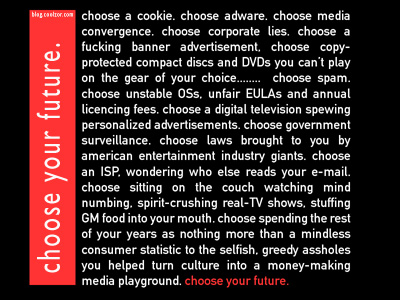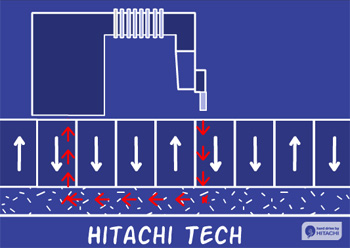I’ve been browsing BlogNewsChannel’s InsideMicrosoft and stumbled upon a very noticeable fact. I didn’t quite get to read it earlier because the ‘a lot to do’ factor in my life took dangerously high proportions. But, nevertheless, it remains a significant item to ‘re-blog’ about.
See I’ve come to the conclusion that the studies that I do include a sort of paradox. In the line of marketing and the research into the lives of potential consumers, it is necessary to be able to gather as much data as possible in order to aim your product advertisement to the right target group. Since the rise of new and digital media, it became very obvious to the marketeers that digital research would become a golden rule. The use of cookies was one of the many means to collect the needed data.
I myself have always been against any outside interference on my computer. Or on any device. I’m very protective when it comes to personal info. I think. At least, I’m trying to be very conscious. For that reason, I delete my cookies, my recently opened this & thats, IE history, everything I can clean will be cleaned. Luckily FireFox does it all by itself. I hate cookies, always have, always will. But the hate is more out of ignorance than out of reason. I’ve never known what the info would be used for. What was written in those files… I never wanted to know.
But the ways of marketing are profound and filled with knowledge. Thus it came to the point where I have to learn to use technology I used to hate so much. Even better: I have to try and find means to reach people who are like me and clean up the trail right after their shadow, every-where they go on the digital paths. So in fact I’ll be designing and using tools that will do things I dislike, as a consumer. But on the other hand, it will return the precious data I so sorely need.
So what does it have to do with InsideMicrosoft? Well, in his post on
‘How to avoid all cookies‘, Nathan Weinberg refers to MacroMedia’s Flash being thrown into battle. The reason why is explained in the following quote :
‘58% of web users have taken to deleting cookies off their machines, so marketers, ever eager to do everything against the customers wishes, are finding a new way to add persistent tracking to your computer: Flash.’
A very interesting point, because almost everybody has a recent version of the flash player installed. This opens a gateway of opportunities to the daring and exploring marketeers.
United Virtualities was the first company to hear the calls for help and Antone Gonsalves published an article about it on Internet Week.
“The New York company on Thursday unveiled what it calls PIE, or persistent identification element, a technology that’s uploaded to a browser and restores deleted cookies. In addition, PIE, which can’t be easily removed, can also act as a cookie backup, since it contains the same information.”
Click here to go there and read it all.
Well. So now there is PIE. Because people like me delete cookies on a regular basis, there is no more data to be collected. The Flash-cookie, as we will call the PIE thing from now, will be stored in the Temp folder.
The ‘why’ about this is explained to us by Mookie Tanembaum on Internet Week :
“The user is not proficient enough in technology to know if the cookie is good or bad, or how it works,” Tanembaum analyses.
So how to delete those Flash-cookies? Is there a way to feel safe again? Yes there is, and Mister Weinberg’s Slashdotted the MacroMedia url for us : Click here to read about your Flash Player Settings.
What will technology bring us next? Marketing experts are always on the lookout for new ways to penetrate into people’s lives.
It’s a good thing I choose to study marketing. At least now I’ll know how I will harass myself and others in particular in the future.



